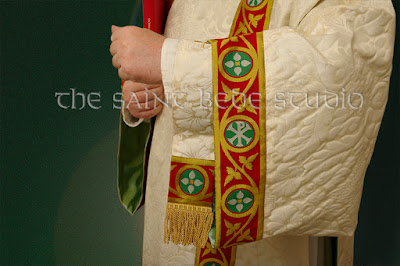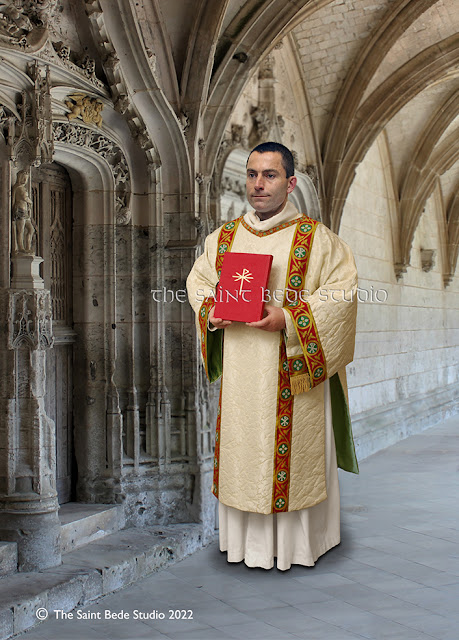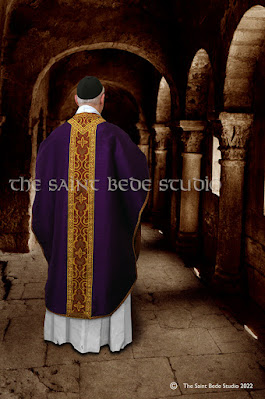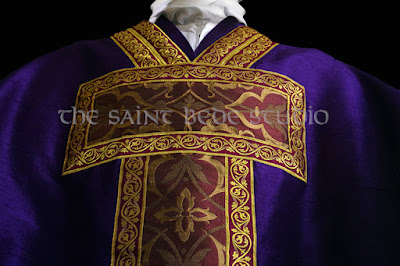 |
A 19th century engraving depicting the Pope, surrounded
by the Papal Court washing the feet of thirteen
poor men of Rome.
This rite took place in the Sistine Chapel on the
morning of Maundy Thursday. |
The practice of the present Bishop of Rome to celebrate the Evening Mass of the Lord's Supper outside of the chapels and basilicas of the Vatican and in places which are not churches, but prisons or hospices, continues to catch the attention of the world. The Pope's decision to wash the feet of girls (as well as boys) and non-Christians during the Mandatum has variously attracted perplexity and rapture.
An analysis of the merits of these divergences is not the purpose of this post. Rather, we wish to give an outline of the history of the Mandatum in order to present reasons why the significance of the Rite is open to different interpretations and philosophies.
The Catholic Encyclopædia (1907-1914) has an article on the history of the Mandatum, written by Herbert Thurston SJ, of which the following is an extract. Father Thurston had written previously about the Mandatum in his monograph Lent and Holy Week (1904):
This tradition, we may believe, has never been interrupted, though the evidence in the early centuries is scattered and fitful. For example the Council of Elvira (A.D. 300) in Canon 48 directs that the feet of those about to be baptised are not to be washed by priests but presumably by clerics or at least lay persons. This practice of washing the feet at baptism was long maintained in Gaul, Milan, and Ireland, but it was not apparently known in Rome or in the East. In Africa the nexus between this ceremony and baptism became so close that there seemed danger of its being mistaken for an integral part of the rite of baptism itself (Augustine, Ep. LV, Ad Jan., n. 33). Hence the washing of the feet was in many places assigned to another day than that on which the baptism took place. In the religious orders the ceremony found favour as a practice of charity and humility. The Rule of St. Benedict directs that it should be performed every Saturday for all the community by him who exercised the office of cook for the week; while it was also enjoined that the abbot and the brethren were to wash the feet of those who were received as guests. The act was a religious one and was to be accompanied by prayers and psalmody, "for in our guests Christ Himself is honoured and received". The liturgical washing of feet (if we can trust the negative evidence of our early records) seems only to have established itself in East and West at a comparatively late date. In 694 the Seventeenth Synod of Toledo commanded all bishops and priests in a position of superiority under pain of excommunication to wash the feet of those subject to them. The matter is also discussed by Amalarius and other liturgists of the ninth century. Whether the custom of holding this Maundy (from Mandatum novum do vobis, the first words of the initial Antiphon) on Maundy Thursday, developed out of the baptismal practice originally attached to that day does not seem quite clear, but it soon became a universal custom in cathedral and collegiate churches. In the latter half of the twelfth century the pope washed the feet of twelve sub-deacons after his Mass and of thirteen poor men after his dinner. The Caeremoniale Episcoporum (1600) directs that the bishop is to wash the feet either of thirteen poor men or of thirteen of his canons. The bishop and his assistants are vested and the Gospel Ante diem festum paschae is ceremonially sung with incense and lights at the beginning of the function. Most of the sovereigns of Europe used also formerly to perform the Maundy. The custom is still retained at the Austrian and Spanish courts.
A number of points may be made here. Although the origin of the Mandatum is a Divine Precept, which the Church has since earliest times considered binding, its expression and its symbolism are by no means clear in liturgical history. On the one hand, it is associated with the Catechumenate, on the other hand with the poor; yet again, a demonstration of the attitude of service which a bishop or religious superior ought to have towards his community.
The question of the Mandatum being linked to Ordination to the ministerial priesthood is somewhat less clear, although it is often spoken about.
What is quite clear, amongst various uncertainties, is that throughout its history, the Mandatum had no relationship with ordinary parish life: it was a rite which pertained to the Diocesan Cathedral or Church of a Religious Community. Only since 1955, with the revisions of the Holy Week Liturgy approved by Pope Pius XII, has the Mandatum been included in the ceremonies of the Evening Mass of the Lord's Supper on Maundy Thursday and consequently, celebrated ordinarily in parishes. Perhaps this revision was not as laudable as was thought at the time.
In the last two decades, we have witnessed the spectacle of all sorts of curious and frightful additions to the Mandatum, advocated by tinpot liturgists (we will refrain from describing any of these dismal accretions). And so, the symbolism of this ancient rite has become obscured again. An unfortunate by-product of this trajectory is that the real focus of the Evening Mass of Maundy Thursday - the Institution of the Blessed Eucharist and Ministerial Priesthood - becomes obscured.
Happily, we note that in both the Ordinary and Extraordinary forms of the Roman Rite, the Mandatum is OPTIONAL. In the more ancient (pre-1955) rites of Maundy Thursday, as we noted, the Mandatum is reserved to the local Bishop's celebration of Holy Week. Its being observed at a time other than during the Evening Mass of the Lord's Supper on Maundy Thursday is something which, we might suggest, might be given serious consideration. Were that to happen, perhaps it would be of lesser consequence if the feet of women were also washed.














